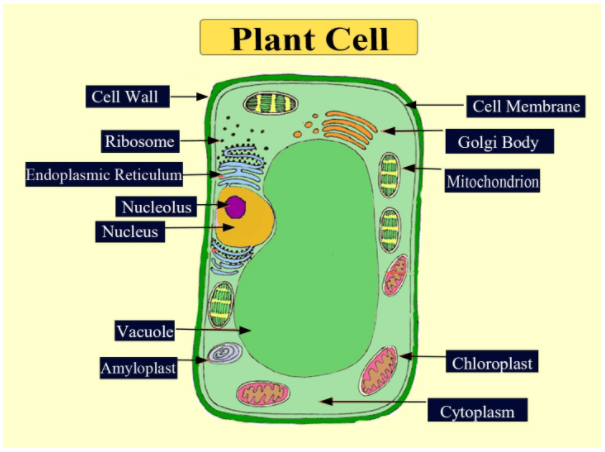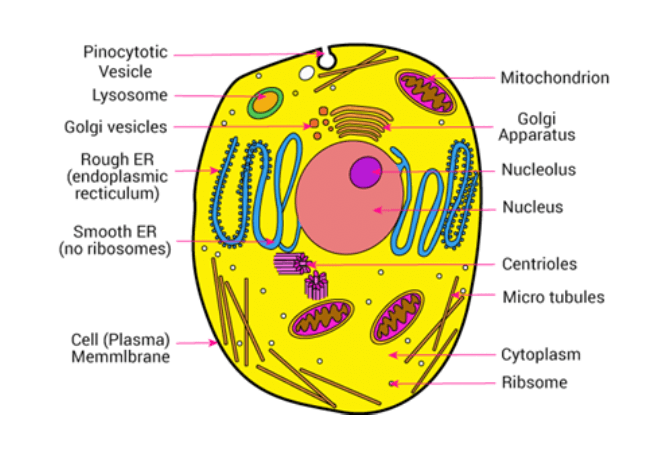As we know a cell is a basic part of creating life. A home is made out of brick, the same as the human body is also made out of cells. Hence, Cells are called living building blocks of life. Nonetheless, in Biology, we learn about two different main types of cells, i.e., Plant and Animal Cells. These both are Eukaryotic cells. These cells have both similarities and differences as well. So here we have discussed the difference between Plant Cells and Animal Cells on the basis of size, Shape, Cell Wall, Presence and Absence of plastids, Presence and Absence of chloroplast, etc. Further, differences are tabulated below.
Difference Between Plant Cell and Animal Cell
The difference between the two is that Plant cells have a true nucleus and certain organelles that perform specific functions while animal cells are a type of eukaryotic cell that lacks a cell wall and has a true membrane-bound nucleus along with other cellular organelles. Also, plant cells are generally larger in size whereas animal cells are generally smaller in size ranging from 10-30 micrometers. The shape of a plant cell is square or rectangular while the animal cells are irregular or round in shape. The other Differences Between Plant Cell and Animal Cell are given below in the table-
| SNo. | Plant cell | Animal cell |
| 1. | They are eukaryotic cells having a true nucleus along with specialized structures known as organelles which perform specific functions. | It is a type of eukaryotic cell that lacks a cell wall and has a true, membrane-bound nucleus along with other cellular organelles. |
| 2. | Mitochondria is present in a small number in plant cells. | In animal cells, Mitochondria is present in large number. |
| 3. | Fixed-size which is generally larger. The normal range is from 10-100 micrometres. | Irregular and small in size. Ranges from 10-30 micrometres. |
| 4. | Plant cells often have a fixed, regular shape due to the rigid cell wall, generally rectangular or cubical. | Animal cells are more flexible in shape, adopting various forms depending on the tissue they are a part of. |
| 5. | Plant Cells are surrounded by rigid wall cell and plasma membrane | Animal Cells are surrounded by flexible and thin plasma membrane |
| 6. | Plastids are present in Plant Cells. | Animal cells do not have plastids. |
| 7. | Plant cells contain chloroplasts, which are responsible for photosynthesis. | There is no chloroplast present in animal cells, therefore cannot perform photosynthesis. |
| 8. | Nucleus lies on one side in plant cells | Nucleous lies in the cell wall’s center in animal cells |
| 9. | Plant cells do not have Cilia. | Animal Cells have Cilia. |
| 10. | Centrioles are absent in plant cells. | Animal cells have centrioles, which are involved in cell division, specifically in organizing the spindle fibers during mitosis and meiosis. |
| 11. | Plant Cells have cell walls which provide structural support and protection to the cell. The cell wall is composed of the cell membrane and cellulose. | Animal cells do not have a cell wall Animal Cells have a flexible cell membrane that regulates the movement of substances in and out of the cell. |
| 12. | Glyoxysomes may be present in plant cells. | Glyoxysomes are not present in animal cells. |
| 13. | Plant cells typically lack lysosomes but have specialized vesicles called lytic vacuoles that perform similar functions. | Animal cells contain lysosomes, which are membrane-bound organelles responsible for breaking down waste materials and cellular debris. |
| 14. | Plan Cells don't have Centrosomes. | Centrosomes are present in Animal cells. |
| 15. | Generally large and provide structural support. One huge vacuole. | Vacuoles are small in size but are many in number any vacuoles. |
| 16. | Plant cells can synthesize their own nutrients such as amino acids, and vitamin coenzymes that are required by the plant. | Animal cells cannot synthesize their own nutrients. |
| 17. | In plant cells, reserve food is present as starch. | In animal cells, reserve food is present as complex carbohydrates and glycogen. |
Similarities Between Plant Cell and Animal Cell
Despite their differences, plant cells and animal cells also share several similarities as they are both eukaryotic cells. These similarities underscore the common eukaryotic origin of plant and animal cells and highlight the fundamental biological processes shared between them. Some of the key similarities include:
| SNo. | Description |
| 1. | Both plant cells and animal cells have a cell membrane, also known as the plasma membrane. The cell membrane is a semi-permeable barrier that controls the movement of substances in and out of the cell. |
| 2. | Ribosomes, responsible for protein synthesis, are present in both types of cells. They can be free-floating in the cytoplasm or bound to the endoplasmic reticulum. |
| 3. | Plant cells and animal cells both contain a nucleus, which houses the cell's genetic material (DNA) and controls cell activities. The nucleus is surrounded by a nuclear membrane that separates it from the cytoplasm. |
| 4. | Plant cells and animal cells have a nucleolus inside the nucleus, which is involved in the synthesis of ribosomes. |
| 5. | Both cell types contain peroxisomes, which are involved in various metabolic reactions, including the breakdown of fatty acids and detoxification of harmful substances. |
| 6. | Both plant and animal cells have cytosol, the gel-like substance that fills the cell and surrounds organelles. |
| 7. | Plant cells and animal cells have a cytoskeleton, which is a network of protein filaments that provides structural support, aids in cell movement, and helps in cell division. |
| 8. | Both plant cells and animal cells contain mitochondria, which are the powerhouses of the cell responsible for generating energy through cellular respiration. |
| 9. | Both types of cells have an endoplasmic reticulum, which is a network of membranes involved in protein synthesis, lipid metabolism, and detoxification of drugs and toxins. |
Plant Cell Structure
Kingdom Plantae majorly contains multicellular eukaryotes living things that are autotrophs by nature. Moreover, The organelles inside the plant cells such as chloroplast, cell wall, and vacuole, help in differentiating them from animal cells. Generally, the size of plant cells ranges from 10-100 µm. Plant cells are responsible for performing the function of photosynthesis. As a result, plants are referred to as autotrophs. It is done due to the presence of chlorophyll inside the chloroplast of the plant cells.

Cell Wall
The cell wall of the plant cell is composed of cellulose, pectin, and hemicellulose. The location of the cell wall is outside the cell membrane. The vital function of the cell wall is to protect and provide structural support to the cell. Also, the plant cell wall is also involved in protecting the cell against mechanical stress and providing form and structure to the cell.
Cell membrane
The membrane of a plant cell is the semi-permeable membrane that is present within the cell wall. The composition of this membrane is a thin layer of protein and fat. Its main function is to regulate the entry and exit of specific substances within the cell.
Nucleus
This part of the plant cell is a membrane-bound structure that is present only in eukaryotic cells. The primary function of a nucleus is to store DNA or hereditary information required for cell division, metabolism, and growth. The Nucleus consists of the nucleolus and nucleopore.
Nucleolus
The nucleolus inside the nucleus manufactures cell protein-producing structures and ribosomes.
Nucleopore
The nuclear membrane is perforated with holes which are referred to as nucleopore that allow proteins and nucleic acids to pass through.
Plastids
Plastids are membrane-bound organelles that have their own DNA. The most important function of Plastids is photosynthesis and storage.
Chloroplasts
Each chloroplast contains a green-colored pigment called chlorophyll which is required for the process of photosynthesis. The chlorophyll absorbs light energy from the sun and utilizes it to transform carbon dioxide and water into glucose.
Central Vacuole
Central Vacuole occupies 30% of the cell volume in a mature plant cell. The Central vacuole is surrounded by tonoplast. The primary function of the central vacuole apart from storage is to sustain turgor pressure against the cell wall.
Golgi Apparatus
The main function of this organelle is the packaging and secretion of proteins.
Ribosomes
These are the smallest membrane-bound organelles that comprise RNA and protein. The function of this organelle is a synthesis of protein.
Mitochondria
They are popularly known as the “Powerhouse of the cells”. The main function of mitochondria is to produce energy.
Lysosome
Lysosomes are called “Suicidal bags” as they hold digestive enzymes in an enclosed membrane. They perform the function of cellular waste disposal.
Function Of Plant Cell
Photosynthesis is a vital function performed by plant cells. Photosynthesis occurs inside the chloroplasts of the plant cell. It is the process of preparing food by plants, by using sunlight, carbon dioxide, and water. Energy is also produced in the form of ATP during the process of photosynthesis.
Animal Cell Structure
They are eukaryotes that have membrane-bound nuclei. Animal cells are different from plant cells in that they do contain cell walls and chloroplast. Animal cells are generally smaller in size than plant cells. The other distinct character is its irregular shape the reason for the irregularity of its shape is the absence of a cell wall, unlike plant cells.

A classic animal cell comprises the following cell organelles:
Cell Membrane
It is a semipermeable membrane that protects the cell from its surroundings. Also, it regulates the entry and exit of nutrients and other microscopic entities into the cell.
Nucleus
It is an organelle that contains other sub-organelles such as nucleolus, nucleosomes, and chromatins. The Nucleus carries genetic material and DNA.
Nuclear Membrane
It is a double membrane that surrounds the nucleus.
Centrosome
It is near the nucleus and is smaller in size. The centrosomes are the organelle where microtubules are produced.
Lysosome
This organelle is rounded and surrounded by a membrane and comprises digestive enzymes which help in digestion, removal of waste, and the cell renewal process.
Cytoplasm
This is a jelly-like material that has all the cell organelles, enclosed within the cell membrane.
Golgi Apparatus
It acts as a factory where proteins received from the ER are further processed and sorted for transport to their eventual destinations.
Mitochondria
An organelle having spherical or rod-shaped with a double membrane. They are considered the powerhouse of a cell as they play an important role in releasing energy.
Ribosomes
Small organelles are made up of RNA-rich cytoplasmic granules, and they are the sites of protein synthesis.
Endoplasmic Reticulum (ER)
It consists of a network of membranous sacs called cisternae that branches off from the nuclear membrane. There are two types of ER, rough endoplasmic reticulum and smooth endoplasmic reticulum. It functions in transporting proteins synthesized by the ribosomes.
Vacuole
It functions in maintaining shape and storing water, food, wastes, etc.
Function Of Animal Cell
The important functions of an animal cell include giving the animal's body a proper structure, absorbing nutrients to convert into energy, and helping the movements of animals. They also contain all the genetic material of an organism and can make copies
